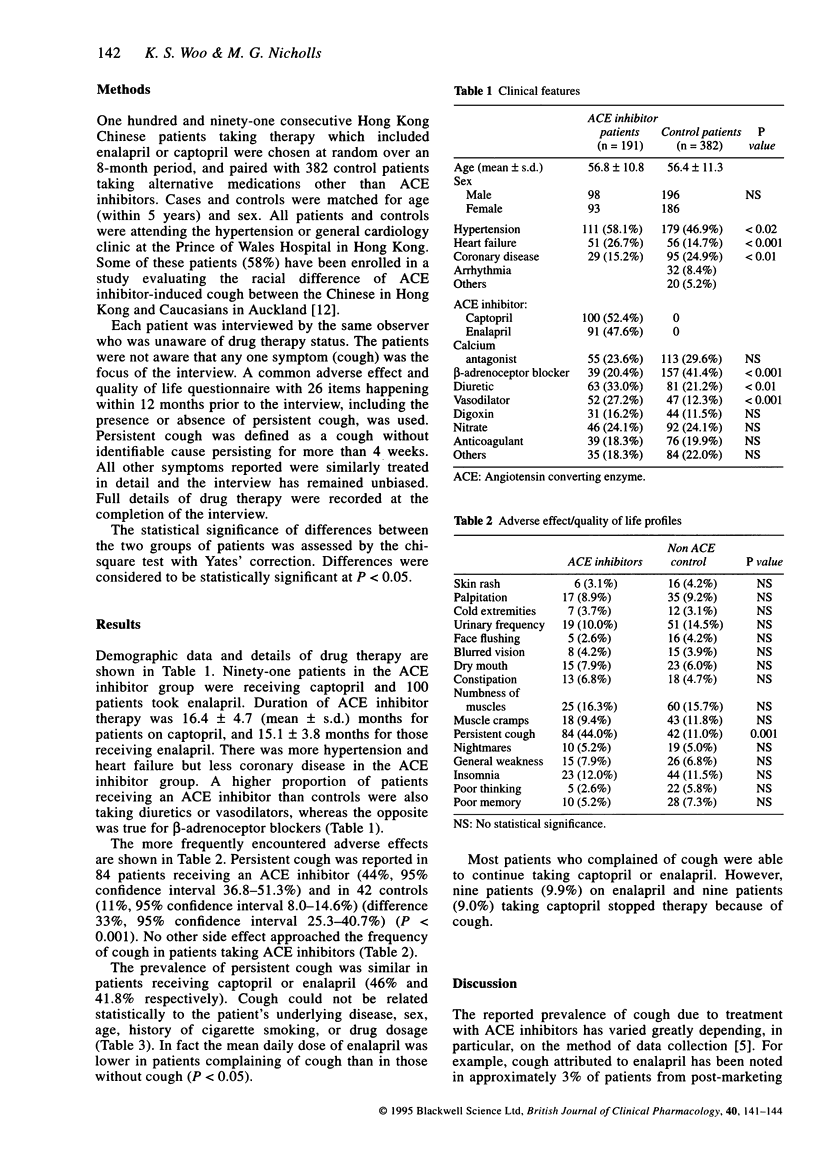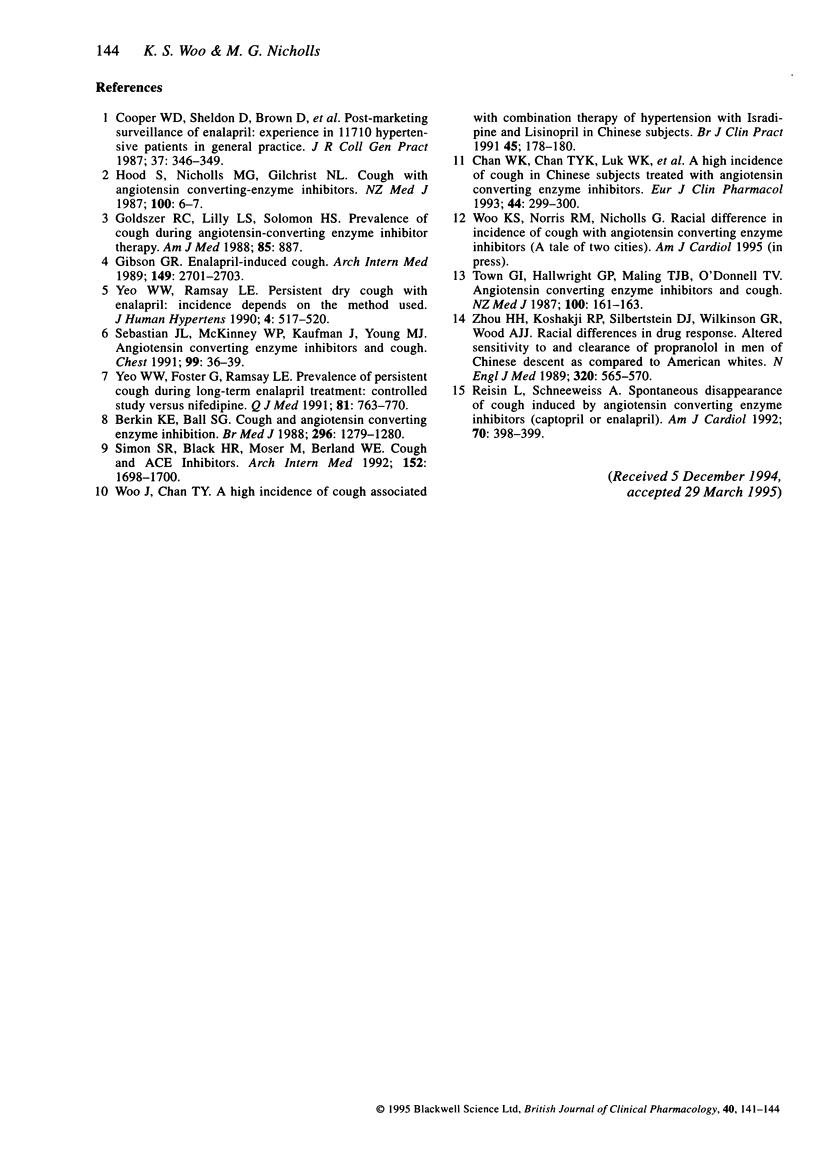Abstract
1. Angiotensin converting enzyme (ACE) inhibitors are in common use for the treatment of hypertension and heart failure. Whereas they are, in general, well tolerated, a dry cough can develop which, on occasion, requires termination of therapy. The reported prevalence of cough with ACE inhibitor therapy has varied from 0.2 to 25%, depending upon methods of data collection, analysis and symptom reporting. 2. To evaluate the prevalence of cough in Chinese patients receiving ACE inhibitors, interviews were carried out in 191 patients in Hong Kong who were taking therapy which included captopril or enalapril for hypertension or heart failure, and 382 patients matched for sex and age receiving alternative medications which excluded an ACE inhibitor (controls). Patients and controls were interviewed in a blinded manner by the same interviewer using a common adverse-effect questionnaire. 3. Persistent cough was reported in 44% of patients taking an ACE inhibitor (46% of those receiving captopril and 41.8% of patients taking enalapril), and in 11.1% of the controls (P < 0.001). The prevalence of other adverse reactions was similar, with no significant difference between the two treatment groups. The complication of cough was not related significantly to age, sex, underlying disease, drug dosage or smoking status. 4. This study indicates that cough is a common side effect of treatment with ACE inhibitors in Hong Kong Chinese, although in most patients cessation of therapy is not required. Whether Chinese are particularly susceptible to ACE-inhibitor cough requires a formal prospective study comparing Chinese and non-Chinese patients.
Full text
PDF



Selected References
These references are in PubMed. This may not be the complete list of references from this article.
- Berkin K. E., Ball S. G. Cough and angiotensin converting enzyme inhibition. Br Med J (Clin Res Ed) 1988 May 7;296(6632):1279–1279. doi: 10.1136/bmj.296.6632.1279. [DOI] [PMC free article] [PubMed] [Google Scholar]
- Chan W. K., Chan T. Y., Luk W. K., Leung V. K., Li T. H., Critchley J. A. A high incidence of cough in Chinese subjects treated with angiotensin converting enzyme inhibitors. Eur J Clin Pharmacol. 1993;44(3):299–300. doi: 10.1007/BF00271377. [DOI] [PubMed] [Google Scholar]
- Cooper W. D., Sheldon D., Brown D., Kimber G. R., Isitt V. L., Currie W. J. Post-marketing surveillance of enalapril: experience in 11,710 hypertensive patients in general practice. J R Coll Gen Pract. 1987 Aug;37(301):346–349. [PMC free article] [PubMed] [Google Scholar]
- Gibson G. R. Enalapril-induced cough. Arch Intern Med. 1989 Dec;149(12):2701–2703. [PubMed] [Google Scholar]
- Goldszer R. C., Lilly L. S., Solomon H. S. Prevalence of cough during angiotensin-converting enzyme inhibitor therapy. Am J Med. 1988 Dec;85(6):887–887. doi: 10.1016/s0002-9343(88)80047-0. [DOI] [PubMed] [Google Scholar]
- Hood S., Nicholls M. G., Gilchrist N. L. Cough with angiotensin converting-enzyme inhibitors. N Z Med J. 1987 Jan 28;100(816):6–7. [PubMed] [Google Scholar]
- Reisin L., Schneeweiss A. Spontaneous disappearance of cough induced by angiotensin-converting enzyme inhibitors (captopril or enalapril). Am J Cardiol. 1992 Aug 1;70(3):398–399. doi: 10.1016/0002-9149(92)90630-h. [DOI] [PubMed] [Google Scholar]
- Sebastian J. L., McKinney W. P., Kaufman J., Young M. J. Angiotensin-converting enzyme inhibitors and cough. Prevalence in an outpatient medical clinic population. Chest. 1991 Jan;99(1):36–39. doi: 10.1378/chest.99.1.36. [DOI] [PubMed] [Google Scholar]
- Simon S. R., Black H. R., Moser M., Berland W. E. Cough and ACE inhibitors. Arch Intern Med. 1992 Aug;152(8):1698–1700. [PubMed] [Google Scholar]
- Town G. I., Hallwright G. P., Maling T. J., O'Donnell T. V. Angiotensin converting enzyme inhibitors and cough. N Z Med J. 1987 Mar 25;100(820):161–163. [PubMed] [Google Scholar]
- Woo J., Chan T. Y. A high incidence of cough associated with combination therapy of hypertension with isradipine and lisinopril in Chinese subjects. Br J Clin Pract. 1991 Autumn;45(3):178–180. [PubMed] [Google Scholar]
- Yeo W. W., Foster G., Ramsay L. E. Prevalence of persistent cough during long-term enalapril treatment: controlled study versus nifedipine. Q J Med. 1991 Sep;80(293):763–770. [PubMed] [Google Scholar]
- Yeo W. W., Ramsay L. E. Persistent dry cough with enalapril: incidence depends on method used. J Hum Hypertens. 1990 Oct;4(5):517–520. [PubMed] [Google Scholar]
- Zhou H. H., Koshakji R. P., Silberstein D. J., Wilkinson G. R., Wood A. J. Altered sensitivity to and clearance of propranolol in men of Chinese descent as compared with American whites. N Engl J Med. 1989 Mar 2;320(9):565–570. doi: 10.1056/NEJM198903023200905. [DOI] [PubMed] [Google Scholar]


